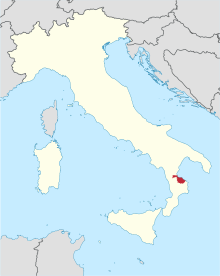Roman Catholic Archdiocese of Rossano-Cariati
| Archdiocese of Rossano-Cariati Archidioecesis Rossanensis-Cariatensis[1] | |
|---|---|
| Location | |
| Country | Italy |
| Ecclesiastical province | Cosenza-Bisignano[1] |
| Statistics | |
| Area | 1,415 km2 (546 sq mi) |
| Population - Total - Catholics |
(as of 2010) 137,500 135,000 (98.2%) |
| Parishes | 53 |
| Information | |
| Denomination | Catholic Church |
| Rite | Latin Rite |
| Established | 597[2] |
| Cathedral | Cattedrale di Maria SS. Achiropita (Rossano)[2] |
| Co-cathedral | Concattedrale di S. Michele Arcangelo (Cariati)[2] |
| Patron saints |
Maria Achiropita Nilo da Rossano Leonardo Abate Cataldo Vescovo[2] |
| Secular priests | 67[1] |
| Current leadership | |
| Pope | Francis |
| Archbishop | Santo Marcianò;[1] Rev. Fr. Giuseppe Satriano, V.G., is the Archbishop-designate |
| Map | |
 | |

The Italian Catholic Archdiocese of Rossano-Cariati (Latin: Archidioecesis Rossanensis-Cariatensis) in Calabria, has existed since 597 beginning as the Diocese of Rossano. It is a suffragan of the archdiocese of Cosenza-Bisignano.[1]
History
In 597, the Diocese of Rossano was established from the former Diocese of Thurio.[2]
In 982 Emperor Otto II captured Rossano temporarily from the Byzantines, who had made it the capital of their possessions in Southern Italy. It preserved its Greek character long after its conquest by the Normans.[3]
The first known bishop of this see is Valerianus, Bishop of the "Ecclesia Rosana" in the Roman Council of 680. Cappelletti, however, names a certain Saturninus as first bishop.[3]
In 1460, the Diocese was elevated to an Archdiocese[2] immediately subject to the Holy See.[1] The famous Codex Rossanensis was discovered in 1879 in the cathedral sacristy, see Batiffol (below).[3] On February 13, 1919, the Diocese had territory transferred to create the Eparchy of Lungro for the Italo-Albanian Catholic Church.[2] On April 4, 1979, the Archdiocese was merged with the Diocese of Cariati to become the Archdiocese of Rossano e Cariati. On September 9, 1986, the Archdiocese was rename to Archdiocese of Rossano–Cariati[1] On January 30, 2001, the Archdiocese of Cosenza-Bisignano was elevated to a Metropolitan See with Rossano-Cariati as a suffragan diocese.[4]
Rite
In the tenth century, or perhaps earlier, the Greek Rite was introduced at Rossano, and continued until the sixteenth century, although two attempts were made to introduce the Latin Rite — once in 1092, and again by Bishop Matteo de' Saraceni in 1460. Priests of the Latin Rite, however, were often appointed bishops.[3] The Greek Rite was maintained especially by the seven Basilian monasteries in the diocese, the most famous of which was Santa Maria in Patiro. In 1571 the Greek Rite was abandoned in the cathedral, and half a century afterwards throughout the city.
Bishops
Among the archbishops were:
- Juan Rodríguez de Fonseca (1519-1524), architect of the colonization of New Spain;
- Vincenzo Pimpinella (1525), nuncio to Germany;
- Giovanni Battista Castagna (1553), afterwards Pope Urban VII;
- Lucio Sanseverino;
- Pier Antonio Spinelli (1628) and Jacopo Carafa (1646), both of whom restored and embellished the cathedral.[3]
Diocese of Turio
The archdiocese includes the ancient Diocese of Turio (Thurii), a city which arose after the destruction of Sybaris; five of its bishops are known, the first being Giovanni (501) and the last Guglielmo (1170).[3]
References
- 1 2 3 4 5 6 7 Cheney, David M. "Archdiocese of Rossano-Cariati". All Dioceses. catholic-hierarchy.org. Retrieved 5 January 2012.
- 1 2 3 4 5 6 7 "Archdiocese of Rossano–Cariati". Catholic Dioceses in the World. GCatholic.org. Retrieved 6 January 2012.
- 1 2 3 4 5 6
 "Rossano". Catholic Encyclopedia. New York: Robert Appleton Company. 1913.
"Rossano". Catholic Encyclopedia. New York: Robert Appleton Company. 1913. - ↑ Cheney, David M. "Archdiocese of Cosenza-Bisignano". All Dioceses. catholic-hierarchy.org. Retrieved 5 January 2012.
Notes
- Cappelletti, Le Chieze d'Italia, XXI;
- Battifol, L'abbaye de Rossano (Paris, 1891)
- Gay, Les dioceses de Calabre a l'epoque byzantine (Macon, 1900)
![]() This article incorporates text from a publication now in the public domain: Herbermann, Charles, ed. (1913). Catholic Encyclopedia. New York: Robert Appleton.
This article incorporates text from a publication now in the public domain: Herbermann, Charles, ed. (1913). Catholic Encyclopedia. New York: Robert Appleton.
| ||||||
Coordinates: 39°34′30″N 16°38′07″E / 39.5750°N 16.6353°E